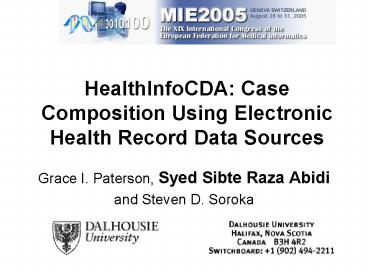HealthInfoCDA: Case Composition Using Electronic Health Record Data Sources - PowerPoint PPT Presentation
1 / 11
Title:
HealthInfoCDA: Case Composition Using Electronic Health Record Data Sources
Description:
HealthInfoCDA: Case Composition Using Electronic Health Record Data Sources. Grace I. Paterson, Syed Sibte Raza Abidi. and Steven D. Soroka ... – PowerPoint PPT presentation
Number of Views:46
Avg rating:3.0/5.0
Title: HealthInfoCDA: Case Composition Using Electronic Health Record Data Sources
1
HealthInfoCDA Case Composition Using Electronic
Health Record Data Sources
- Grace I. Paterson, Syed Sibte Raza Abidi
- and Steven D. Soroka
2
Guiding Principle Leverage standards associated
with Health Level 7 (HL7) Clinical Document
Architecture (CDA) to develop an infostructure
for clinical care and education
3
Goal
- Capture clinical experience in a case-based
reasoning (CBR) system from - Input 1 electronic discharge summaries
- Input 2 longitudinal electronic health records
- Input 3 guidelines and online handbooks
- Evaluate the HL7 Clinical Document Architecture
(CDA) model as a boundary object that - represents clinical activity
- supports information flow
- bridges practice and theory through a CBR system
4
Creation of a CDA Document
- Separate header and body data in source
- Identify sections
- Identify clinical statements in each section
- Identify entries (ActEncounterObservation
ProcedureSubstanceAdministration...) in each
clinical statement - Identify codes or code-sets for each entry
5
Electronic Discharge Summary
- Objective produce discharge summaries that are
more complete and contain more of the essential
data elements - Method create CDA document--Chronic Kidney
Disease Discharge Summaryusing a Template - Subjects Nephrologists, Residents, Nurse
Practitioners (N5) - Results all beta-testers found the amount of
content was appropriate, but requested
improvements in layout and interface design.
6
Lessons Learned
- Variation in what Communities of Practice choose
to observe - Specialists are most parsimonious
- Record-keeping skills are not explicitly taught
- Template layout should accommodate different
charting styles - Discharge Diagnosis is common to all
- Health Status is inconsistent because it is
subjective - Concept Coding requires attention to semantic
classes
7
Longitudinal Health Care Record
- Objective Identify and encode clinical
statements from documents in patient chart - Method
- identify concepts in text using natural language
processing tools and encode to SNOMED UMLS - transform paper chart to CDA documents
- use HL7 Clinical Statement Pattern in Sept 2005
HL7 Ballot Package for document construction - Result structures that retain care context and
support case composition
8
Guidelines and Online Handbooks
- Objective Aggregate concepts into knowledge
elements for case-based teaching - Method
- identify concepts in text using natural language
processing tools and encode to SNOMED UMLS - produce knowledge elements for concepts
- aggregate knowledge elements using clinical
action reference model - Results A method for achieving semantic
interoperability between Observations and Actions
in CDA and Policies and Decision knowledge
resource
9
Observations
Communities of Practice
Policies
SNOMED
HL7 CDA
Collaboration
Communication
Structure of a Document
Meaning of a Concept
Knowledge Transfer
Actions
Decisions
10
Case-Based Reasoning
- Structural mapping between CDA-based electronic
health record and Case - Problem/Situation Description history,
observations - Solution clinician inferences in assessment
- Outcome resulting state expressed as followup
instructions to next clinician - SNOMED as switching language between concepts in
case base and knowledge sources - Produce learning objects for chronic disease
management activitiescondition tracking,
condition assessment, care planning
11
Learning Object Example































